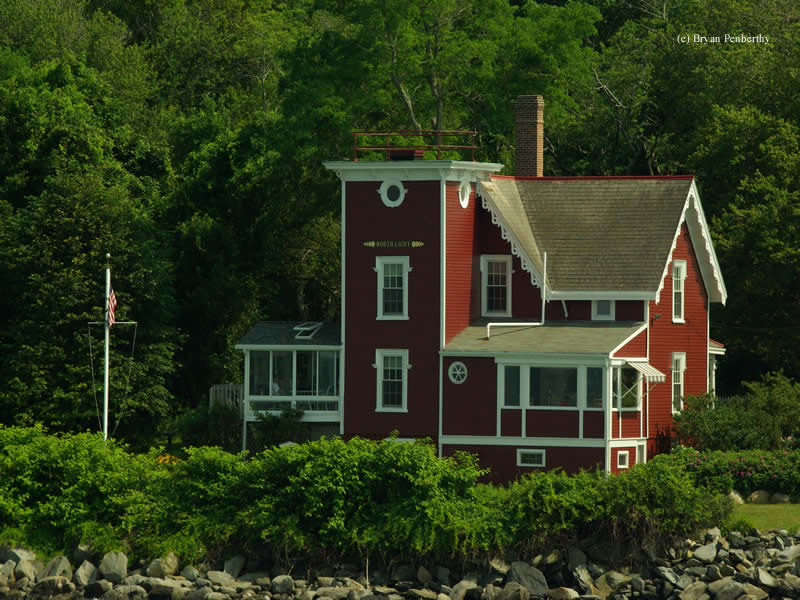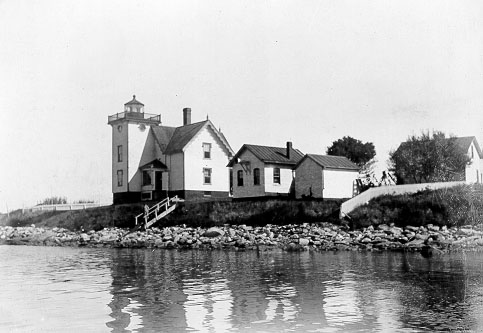Conanicut Island Lighthouse
Jamestown, Rhode Island - 1886 (1886**)

History of the Conanicut Island Lighthouse
Posted/Updated by Bryan Penberthy on 2012-11-28.
Conanicut Island is the second largest island in Narragansett Bay, second only to the island of Aquidneck. However, it is Conanicut Island that sits in the middle of the bay creating the East and West Passages for shipping traffic.
Prior to the 1870, Conanicut Island was mostly agricultural. However, in 1870, the Wickford Railroad and Steamboat Company began a steamship service between Wickford and Newport. This allowed New York's wealthy residents to board a train in New York operated by The New York, Providence, & Boston Railroad Company which provided service to Wickford. From there, the passengers could enjoy a 75-minute ferry service to Newport. Many New Yorker's favored this route to the longer Long Island steamer service. This was the start of area's increasing popularity as a vacation destination.
As a result of the increased steamship traffic, the Wickford Railroad and Steamboat Company had constructed a private aid to navigation on the northern tip of Conanicut Island. However, as early as 1882, they began to petition Congress for a lighthouse at that location. It appears that the Federal Government may have started looking at plots of land as early as 1883 as evidenced by the entry in the Annual Report of the Lighthouse Board dated 1883:
Conanicut Island, Newport Harbor, Rhode Island - A delay in procuring title to the site desired for the light-house has prevented, thus far, the establishment of the light. There is now a prospect of securing title, and, in the mean time, preparations for commencing work upon the structure have been made.
The petitions paid off and on July 7, 1884, Congress appropriated $18,000 for a lighthouse at northern tip of Conanicut Island. However, there was some delay due to a member of the Conanicut Park Land Company being out of the country, and the Lighthouse Board having to wait on the signature. By the middle of 1885, work had started on the lighthouse and by the end of the season, it was just about complete.
As the lighthouse was not completed, a temporary light was set up at the point to help guide mariners. It was of little use to the steamer Eolus which ran aground on a shoal just west of the lighthouse during a blinding snowstorm. All passengers were transported to shore by small boats and were housed in local farmhouses.
By early spring, work resumed on the lighthouse. The lighthouse keeper's dwelling appeared to have Victorian influences with its gingerbread trim and gabled roof. The tower arose from the northeast corner of the dwelling and provided a lantern for the fifth order Fresnel lens. A fixed white light was first displayed on April 1, 1886.
The Annual Report of the Lighthouse Board dated 1886 had the following entry:
133. Conanicut Island, Rhode Island - Some delay was occasioned in the commencement of the construction of this light-station by the absence in Europe of one of the Conanicut Park Land Company, whose signature was required in perfecting the title-papers. The title was, however, perfected and approved early in the fiscal year, and operations at the site were at once commenced and pushed until the end of the working season, at which time the station was substantially completed. The lens apparatus was fitted in the spring and the light exhibited on April 1, 1886 for the first time.
The station, upon completion in 1886, was equipped with a fog bell. Entries in the Annual Report of the Lighthouse Board dated 1893 show that fog bell apparatus was overhauled and repaired. It also reports that a breakwater was constructed to protect the shoreline and the space between the breakwall and bank was filled with stone.
In 1897, the Annual Report of the Lighthouse Board shows that the characteristic of the fog bell was changed from a double blow every thirty seconds to a double blow every ten seconds. Other work to take place around the station was the construction of a small barn and repairs to the seawall. From the entry, it also appears that steps were built into the seawall.
194. Conanicut Island, Rhode Island - A small barn was built, the sea wall was repaired, solid steps were set in the face of the wall, and landing steps were made and fitted from the sea wall to the terrace. On June 1, 1897, the characteristic of the fog bell were changed to a double blow every 10 seconds instead of a double blow every 30 seconds.
 Conanicut Island Lighthouse (Courtesy Coast Guard)
Conanicut Island Lighthouse (Courtesy Coast Guard)
The year 1900 saw some improvements to the station including an 833 gallon water tank. The other major improvement was the installation of an air siren operated by a two-and-one-half horsepower oil-burning engine. It was established on June 30, 1900.
The first year of service, the unit operated a total of 336 hours, and consumed 116 gallons of oil. By 1901, the unit was overhauled, and a heater was installed to prevent the engine from freezing. 1901 also saw the construction of a brick oil house. The fog signal was upgraded in 1907 and a new brick structure was built to house the equipment.
A decrease in shipping traffic and recent advancements in automation led to the station's demise. It was deactivated in 1933, and navigational duties were transferred to a fifty-foot skeletal tower that was constructed fifty-five feet east of the lighthouse. The skeletal light was discontinued on April 21, 1982, and the tower was removed.
The lantern atop the lighthouse was removed in 1934. The half-acre of land, the lighthouse, and out-buildings were sold at auction to Mahlon G. Dunn for $2,785.
Over the forty-six year history that the station was in operation, there were only two lighthouse keepers to serve the post. The first keeper was Horace Arnold whom was transferred from the Conimicut Lighthouse in the Providence River. He would be replaced by Elmer V. Newton upon his death in February of 1914. Newton would serve until the station's closure in 1932.
Note: The lighthouse is private property, please respect this and do not trespass.
Reference:
- America's Atlantic Coast Lighthouses (6th edition), Jeremy D'Entremont, 2005.
- Annual Report of the Light House Board, U.S. Lighthouse Service, Various years.
- Northeast Lights - Lighthouses and Lightships, Robert G. Bachand, 1989.
- The Lighthouse Handbook: New England: The Original Field Guide, Jeremy D'Entremont, 2008.
- The Lighthouses of Rhode Island, Jeremy D'Entremont, 2006.
Directions: The lighthouse sits on the north end of Conanicut Island. It is best viewed from the water. Rhode Island Bay Cruises offers a 10 lighthouse cruise that passes by the lighthouse.
Access: The lighthouse is private property. The grounds and tower are closed.
View more Conanicut Island Lighthouse picturesTower Height: 42.00'
Focal Plane: 47'
Active Aid to Navigation: Deactivated (1933)
*Latitude: 41.57400 N
*Longitude: -71.37200 W
See this lighthouse on Google Maps.
